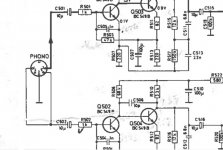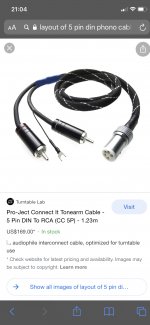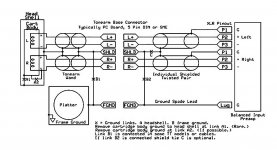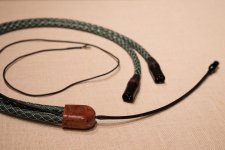They are balanced by definition. Each leg has the same impedance and they are not connected to ground.
Then explain this to me, as I see a grounding connection there.
This is from a Tandberg receiver.
Attachments
Evidence from one preamp is not evidence about all cartridges, and there are counterexamples from the world of preamps. You have to show that one leg is always grounded by all cartridges to sustain your claim, and you haven't done so. In fact you can't.
Evidence from one preamp is not evidence about all cartridges, and there are counterexamples from the world of preamps. You have to show that one leg is always grounded by all cartridges to sustain your claim, and you haven't done so. In fact you can't.
I love how people tend to argue in online blogs.
Can't figure that crap out.
FYI, ...... ALL stereophonic cartridges have FOUR (sometimes three with a common ground) pins, two of which are SIGNAL GROUNDS.
Consumer audio equipment is designed to accept that design.
In all my years of selling consumer audio, and servicing audio, I see nothing but the facts that I have stated.
You've just proven my point. Why do they have four wires if two of them are signal grounds? Why isn't the earth wire from the TT sufficient?
Try addressing the issue.
Try addressing the issue.
Sorry, it seems I mixed up stuff here.
This is a slightly dim memory for me, mixing up personal experiences as a teenager, mostly using din-rca adapter cables, and everything-german-is-better-lore from my father.
The benefit of 5p-din that i remember correctly is that cable screen is not connected to signal ground, like in xlr.
But there is one ground for all signals, the other two connections are record connections, i.e. in the other direction, which it makes sense to ground if not used with a tape.
Regarding the preamplification, maybe my question should have rather been why did it evolve that all the amplifiers had the riaa correction and level compensation integrated instead the turntables?
It does make sense for tube tech and line level motors, but as soon as you have semiconductors and dc motors surely the power supply can be shared, or at least the transformer.
Well. I am not going to buy any new stuff (hope to find the time at some point to reactivate the inherited (nongerman 😉 ) transscriptor and rabco arm instead, which are not in the best shape), so maybe the question is moot.
This is a slightly dim memory for me, mixing up personal experiences as a teenager, mostly using din-rca adapter cables, and everything-german-is-better-lore from my father.
The benefit of 5p-din that i remember correctly is that cable screen is not connected to signal ground, like in xlr.
But there is one ground for all signals, the other two connections are record connections, i.e. in the other direction, which it makes sense to ground if not used with a tape.
Regarding the preamplification, maybe my question should have rather been why did it evolve that all the amplifiers had the riaa correction and level compensation integrated instead the turntables?
It does make sense for tube tech and line level motors, but as soon as you have semiconductors and dc motors surely the power supply can be shared, or at least the transformer.
Well. I am not going to buy any new stuff (hope to find the time at some point to reactivate the inherited (nongerman 😉 ) transscriptor and rabco arm instead, which are not in the best shape), so maybe the question is moot.
You've just proven my point. Why do they have four wires if two of them are signal grounds? Why isn't the earth wire from the TT sufficient?
Try addressing the issue.
Try arguing with an old, trained and certified, professional electronics technician with 45 years of experience in the home entertainment industry....... like me.
Who refuses to be baited with silly talk.
😱
What has a receiver got to do with my comments on tonearm wiring? Answer: NOTHING.Then explain this to me, as I see a grounding connection there.
This is from a Tandberg receiver.
You mean like you do? Projecting much?I love how people tend to argue in online blogs.
Wrong. For a start Philips used to make cartridges with 5 pins. Secondly if the only connection to 2 pins is a coil, how is one of those pins ground?FYI, ...... ALL stereophonic cartridges have FOUR (sometimes three with a common ground) pins, two of which are SIGNAL GROUNDS.
No. Many tonearms have a 5 pin DIN connector on them, just a different size to the DIN connector that hifi used to (and in the case of NAIM still does) use. A better connector than RCA by almost any parameter you might think of other than snakeoilability.Sorry, it seems I mixed up stuff here.
And so it descends into willy waving. Very low grade willy waving...Try arguing with an old, trained and certified, professional electronics technician with 45 years of experience in the home entertainment industry....... like me.
Who refuses to be baited with silly talk.
😱
Another one insisting on disagreeing and argumentive...
"For a start Philips used to make cartridges with 5 pins."
USED to?..... used to?
More silly talk.
This is tiring, I'm done here.
"For a start Philips used to make cartridges with 5 pins."
USED to?..... used to?
More silly talk.
This is tiring, I'm done here.
1) Balanced has nothing to do with having a ground connection or even producing opposite polarity signals wrt gnd.
Balanced only means that both signals have the same (balanced) output impedances.
2)When inputs receiving balanced lines also have the same (balanced) but much higher input impedances, Common Mode pick up in the interconnect lines will be suppressed, that's its whole purpose.
3) Four wires connected to two coils have nothing to do with any gnd reference and are floating as long as they are not connected to gnd as in most MM carts or at the RCA input of the Phono Preamp.
4) A din connection with 5 wires is capable of carrying 4 floating balanced lines from 2 coils plus one line to extend the PE from the Pre Amp chassis into the cable shielding and to the TT Chassis and Arm.
5) connecting a Cart to gnd, could potentially lead to gnd loops when the cable shield carries PE instead of signal gnd.
Hans
Balanced only means that both signals have the same (balanced) output impedances.
2)When inputs receiving balanced lines also have the same (balanced) but much higher input impedances, Common Mode pick up in the interconnect lines will be suppressed, that's its whole purpose.
3) Four wires connected to two coils have nothing to do with any gnd reference and are floating as long as they are not connected to gnd as in most MM carts or at the RCA input of the Phono Preamp.
4) A din connection with 5 wires is capable of carrying 4 floating balanced lines from 2 coils plus one line to extend the PE from the Pre Amp chassis into the cable shielding and to the TT Chassis and Arm.
5) connecting a Cart to gnd, could potentially lead to gnd loops when the cable shield carries PE instead of signal gnd.
Hans
4)...... Is capable yes, but this is not how it´s done the DIN standard way.
The two "cold" are put together at pin-2, and the plug-tube carries the screen/chassis connection.
The two "cold" are put together at pin-2, and the plug-tube carries the screen/chassis connection.
When buying a phono cable with 5pin din connector no connections are made internally that I know off.
All 4 Cart connections are separately led to two RCA connectors and the extra wire with lug connects to the cables shielding and to the Din’s connecector pin 2.
What happens outside the cable is up to the supplier of the TT and the Phono preamp.
The picture is just meant as an example, there are of course much cheaper versions.
Hans
.
All 4 Cart connections are separately led to two RCA connectors and the extra wire with lug connects to the cables shielding and to the Din’s connecector pin 2.
What happens outside the cable is up to the supplier of the TT and the Phono preamp.
The picture is just meant as an example, there are of course much cheaper versions.
Hans
.
Attachments
Good.This is tiring, I'm done here.
I've never seen that, any examples of tonearms wired that way? My SME has 3 ground wires, one for each STP run screen and one for the tonearm chassis.4)...... Is capable yes, but this is not how it´s done the DIN standard way.
The two "cold" are put together at pin-2, and the plug-tube carries the screen/chassis connection.
This was really useful, thanks. In particular, I had no idea of the difference between balanced and differential.Let me try and summarize this discussion so far and provide my feedback. Feel free to correct/disagree/give-up-in-disgust. 😀
- "balanced" is an overused term. phono inputs are not really balanced in the electrical sense because they lack a reference ground. instead they float and because of this you cannot assure that Vn = -(Vp).
- yes, phono level inputs can be treated as as "balanced" when designing/implementing a phono stage, but a more concise statement would be that front end would be implemented as a difference amplifier (which does not require the symmetry that a true balanced input would provide). some people have already mentioned that their input stages are designed this way. the lack of a common return posses some challenges that need to be addressed in the circuit but it's not an impossible task. this lack of common also makes the use of XLR connectors problematic, given that the X part of XLR is missing.
- while you can go to all the trouble of implementing a differential front end the next question would be what do you gain (sic) by doing so? as pointed out earlier, hum and other sources of noise picked up by the coil/cartridge are not necessarily diminished by this approach. if you have addressed the other critical issues like proper shielding of the leads from cartridge to preamp, elimination of ground loops, etc. then a differential front end doesn't really buy you anything beyond what a good single ended input stage can already deliver.
- remember that the basic S/N ratio coming out of the cartridge is around 70-someodd dB which is well within the capabilities of modern quiet op-amp (or discrete design) SE circuits.
regarding grumpy old men and general curmudgeonly behavior: I cannot claim membership in that club not having quite reached the age of retirement yet. I am a child of the 70's, not the 60's. stay tuned - I'll let you know when I arrive. 😀
for the most part audio today is a consumable/disposable commodity. there is really no incentive for manufactures to make durable goods anymore. take AV receivers as an example. in my house they seem to last an average of 2.5 years before suffering terminal failure. on the other end of the spectrum, upstairs I have.a pair of 40 year old Heathkit amps which are still going strong. but that's okay, I fully acknowledge that I am not your standard audio consumer.
happy new year all!
-b
I guess a lot of my thoughts about avoiding RCA-type single-ended cabling came from wondering what the phono preamp input stage was doing to the ground signals (the outer conductors of the RCA sockets). But then, I guess good single ended phono preamps will always treat that conductor as audio-gnd-ref, not allow it to pick up noise, etc.
All this now makes me wonder about another idea: what do you think of the idea of using 2-core+shield cables for these connections, and connecting the cable shield to the outer connector of the RCA socket at one end? Something like this: Pseudo-Differential Cable: Connect unbalanced source to balanced input – Neurochrome except that one can use RCA plugs at both ends, and connect the shield to the gnd-ref conductor of the RCA plug at one end. Will this sort of thing help reduce noise pickup?
I have Aesthetix Io Phono stage. It has balanced input and output. I built a pair of balanced phono cable years ago. Personally, I can't hear too much of difference between single-end and balanced. Actually, I prefer single-end slightly over the balanced cable. Here was the way I wired the balanced cable. I would like to hear any suggestions if I should wire the cable differently.
Attachments
- Home
- Source & Line
- Analogue Source
- Newbie question about phono signal from cartridge




